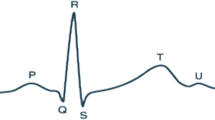Abstract
A method is presented to evaluate the detection performance of real-time QRS detection algorithms to propose a strategy for the adaptive selection of QRS detectors, in variable signal contexts. Signal contexts are defined as different combinations of QRS morphologies and clinical noise. Four QRS detectors are compared in these contexts by means of a multivariate analysis. This evaluation strategy is general and can be easily extended to a larger number of detectors. A set of morphology contexts, corresponding to eight QRS morphologies (normal, PVC, premature atrial beat, paced beat, LBBB, fusion, RBBB, junctional premature beat), was extracted from 17 standard ECG records. For each morphology context, the set of extracted beats, ranging from 30 to 23000, was resampled to generate 50 realisations of 20 concatenated beats. These realisations were then used as input to the QRS detectors, without noise, and with three different types of additive clinical noise (electrode motion artifact, muscle artifact, baseline wander) at three signal-to-noise ratios (5 dB, −5 dB, −15 dB). Performance was assessed by the number of errors, which reflected both false alarms and missed beats. The results show that the evaluated detectors are indeed complementary. For example, the Pan-Tompkins detector is the best in most contexts but the Okada detector generates fewer errors in the presence of electrode motion artifact. These results will be particularly useful to the development of a real-time system that will be able to choose the best QRS detector according to the current context.
Similar content being viewed by others
References
Benitez, D., Gaydecki, P., Zaidi, A., andFitzpatrick, A. (2001): ‘The use of the Hilbert transform in ECG signal analysis’,Comput. Biol. Med.,31, pp. 399–406
Burke, M., andNasor, M. (2004): ‘Wavelet based analysis and characterization of the ECG signal’,J. Med. Eng. Technol.,28, pp. 47–55
Carrault, G., Cordier, M.-O., Quiniou, R., andWang, F. (2003): ‘Temporal abstraction and inductive logic programming for arrhythmia recognition from electrocardiograms’,Artif. Intell. Med.,28, pp. 231–263
Daskalov, I. K., andChristov, I. I. (1999): ‘Electrocardiogram signal preprocessing for automatic detection of QRS boundaries’,Med. Eng. Phys.,21, pp. 37–44
Dotsinsky, I. A., andStoyanov, T. V. (2004): ‘Ventricular beat detection in single channel electrocardiograms’,Biomed. Eng. Online,3
Fraden, J., andNeuman, M. (1980): ‘QRS wave detection’,Med. Biol. Eng. Comput.,18, pp. 125–132
Friesen, G., Jannett, T., Jadallah, M., Yates, S., Quint, S., andNagle, H. (1990): ‘A comparison of the noise sensitivity of nine QRS detection algorithms’,IEEE Trans. Biomed. Eng.,37, pp. 85–98
Gritzali, F. (1988): ‘Towards a generalized scheme for QRS detection in ECG waveforms’,Signal Process.,15, pp. 183–192
Hernández, A. I., Carrault, G., Mora, F., Thoraval, L., Passariello, G., andSchleich, J. M. (1999): ‘Multisensor fusion for atrial and ventricular activity detection in coronary care monitoring’,IEEE Trans. Biomed. Eng.,46, pp. 1186–1190
Jenkins, J. M., andCaswell, S. A. (1996): ‘Detection algorithms in implantable cardioverter defibrillators’,Proc. IEEE,84, pp. 428–445
Kadambe, S., Murray, R., andBoudreaux-Bartels, F. (1999): ‘Wavelet transform-based QRS complex detector’,IEEE Trans. Biomed. Eng.,46, pp. 838–848
Kohler, B.-U., Hennig, C., andOrglmeister, R. (2002): ‘The principles of software QRS detection’,IEEE Eng. Med. Biol. Mag.,21, pp. 42–57
Krzanowski, W. (1998): ‘Principles of multivariate analysis’, inAtkinson, A. C., Copas, J. B., Pierce, D. A., Schervish, M. J., andTitterington, D. M. (Eds): ‘Oxford statistical science series’ (Oxford University Press, Oxford, US, 1998)
Mark, R., andMoody, G. (1988): ‘MIT-BIH arrhythmia data base directory’ (Massachusetts Institute of Technology)
Moody, G., Muldrow, W., andMark, R. (1984): ‘A noise stress test for arrhythmia detectors’,Comput. Cardiol.,11, pp. 381–384
Nygårds, M.-E., andSörnmo, L. (1981): ‘A QRS delineation algorithm with low sensitivity to noise and morphology changes’Proc. IEEE Comput. Cardiol., Florence, Italy, pp. 347–350
Okada, M. (1979): ‘A digital filter for the QRS complex detection’,IEEE Trans. Biomed. Eng.,26, pp. 700–703
Pan, J., andTompkins, W. J. (1985): ‘A real-time QRS detection algorithm’,IEEE Trans. Biomed. Eng.,32, pp. 230–236
Poli, R., Cagnoni, S., andValli, G. (1995): ‘Genetic design of optimum linear and nonlinear QRS detectors’,IEEE Trans. Biomed. Eng.,42, pp. 1137–1141
Passariello, G., Mora, F., Carrault, G., andLe Pichon, J. P. (1993): ‘Intelligent patient monitoring and management systems: a review’,IEEE Eng. Med. Biol. Mag.,12, pp. 23–33
Senhadji, L., Carrault, G., Bellanger, J. J., andPassariello, G. (1992): ‘Some new applications of the wavelet transforms’,14th Ann. Int. Conf. IEEE-EMBS, Paris, France,14, pp. 2592–2593
Shekhar, C., Moisan, S., andThonnat, M. (1994): ‘Towards an intelligent problem-solving environment for signal processing’,Math. Comput. Simul.,36, pp. 347–359
Silipo, R., andMarchesi, C. (1998): ‘Artificial neural networks for automatic ECG analysis’,IEEE Trans. Signal Process.,46 pp. 1417–1425
Sun, Y., Chan, K., andKrishnan, S. (2002): ‘ECG signal conditioning by morphological filtering’,Comput. Biol. Med.,32, pp. 465–479
Wendling, F., Carrault, G., andBadier, J. M. (1997): ‘A comparative study of depth EEG seizure signals: Proposition for a method based on a physiologically relevant parameter’,Ann. Biomed. Eng.,25, pp. 1026–1039
Wieben, O., Afonso, V. X., andTompkins, W. J. (1999): ‘Classification of premature ventricular complexes using filter bank features, induction of decision trees and a fuzzy rule-based system’,Med. Biol. Eng. Comput.,37, pp. 560–565
Zoubir, A. M., andBoashash, B. (1998): ‘The bootstrap and its application in signal processing’,IEEE Signal Process. Mag.,15, pp. 56–76
Author information
Authors and Affiliations
Corresponding author
Rights and permissions
About this article
Cite this article
Portet, F., Hernández, A.I. & Carrault, G. Evaluation of real-time QRS detection algorithms in variable contexts. Med. Biol. Eng. Comput. 43, 379–385 (2005). https://doi.org/10.1007/BF02345816
Received:
Accepted:
Issue Date:
DOI: https://doi.org/10.1007/BF02345816




